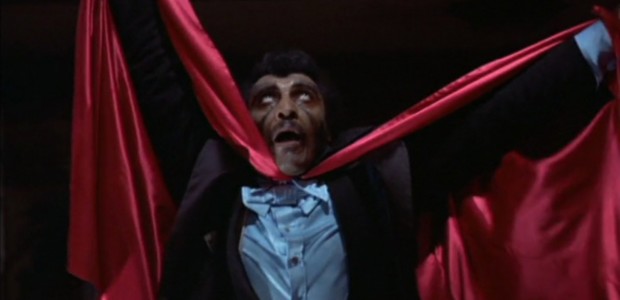Happy All-Hallow’s Month! In anticipation of Halloween — which, let’s face it, we’ve been anticipating since last Halloween — Daily Grindhouse will again be offering daily celebrations of horror movies here on our site. This October’s theme is horror sequels — the good, the bad, the really bad, and the unfairly unappreciated. We’re calling it SCREAMQUELS!
And if you like this feature, please check us out on Patreon for unique reads and deep dives! Just $3 a month gets you everything! All treats, no tricks.
One of my favorite Simpsons jokes comes courtesy of the episode “All’s Fair in Oven War.” As the family huddles around the television, the iconic purple box blares: “We now return to BLACULA MEETS BLACK BLACULA.” In it, a white businessman declares he’s turning a disco into a hockey rink, for which Blacula—dancing next to Black Dracula—responds: “You mean a honky rink.”
Absurd as the joke may be, it hits like a stake in the heart at the idiosyncratic nature of BLACULA. The fact that the 1972 film distributed by Samuel Z. Arkoff’s American International Pictures is neither a campy joke nor conventional Blaxploitation entry has complicated its perception among audiences for decades; if anything, because one doesn’t naturally associate pun-riddled exploitation fare with a classical Shakespearian tragedy, which William Crain’s original film undeniably is. It’s all too easy to sit down for a first-time viewing of BLACULA and expect the same trashy lows of BLACKENSTEIN, but it’s harder yet, once you’ve seen it, to square the ridiculous title with the film’s world-weary self-seriousness. It’s also normal to wonder: “Wait? I thought Blacula was Black Dracula?”
No, Blacula is not Black Dracula. The monster, brought to life by the even larger-than-life William Marshall, has a much more creative—and insidious—backstory. Before he was the unfortunately-named bloodsucking creature of the night, he was Prince Mamuwalde, an African prince traveling to Count Dracula’s castle to convince the Transylvanian man of leisure to stop engaging in the slave trade. Dracula is so offended by the proposition, he turns Mamuwalde into a vampire and murders his wife. The dastardly Count rechristens the prince “Blacula” and imprisons him in a coffin for two hundred years, until he is awakened in modern day (1972) Los Angeles.

The subtext here isn’t exactly sub. The character of Blacula is a through-line from our white supremacist past to its sprawling patchwork of destruction in the present moment. Blacula feeds off the Black population because of a white man’s disease, a permanent affliction that prevents him from self-actualization and happiness. His story is one of endless suffering, his evil heart its inevitable byproduct.
Unfortunately, Crain didn’t have the genre chops to marry these ideas effectively with the horror elements, and the original BLACULA remains a pretty good romance wrapped inside an okay horror film. Seemingly cognizant of this, Sam Arkoff tapped director Bob Kelljan for the sequel, SCREAM, BLACULA, SCREAM, as Kelljan had already made COUNT YORGA, VAMPIRE and THE RETURN OF COUNT YORGA. The new director acquits himself excellently with the horror, but the sequel has two additional secret weapons: Pam Grier fresh off COFFY and a batshit insane story.
Grier co-stars as Lisa Fortier, the adopted daughter of voodoo queen Mama Loa. Chosen as Mama Loa’s successor, Lisa banishes the queen’s actual son Willis from the clan when he claims his rights as heir. Pissed off, Willis obtains the bones of Blacula and uses voodoo to resurrect him and learns a lesson as old as time (something about playing with power beyond one’s comprehension). Blacula turns Willis into a vampire and steals his house.

Blacula, meanwhile, senses the true power of Lisa’s voodoo and seeks her help in reversing the vampire curse. Lisa’s boyfriend, Justin (Don Mitchell), an ex-detective, pieces together that the Nigerian gentleman hanging out with his woman is an ancient bloodsucker and develops a Van Helsing-like obsession to exterminate him. All of this builds into a final showdown between voodoo, vampires, and police, creating one of the most unusual and unique vampire films in the process.
Kelljan’s film ditches whatever social consciousness the original may have had for stormy nights, jump scares, and long, steady shots of vampires rising from coffins. Marshall, too, appears to have shed his pretentious, classically-trained vibe and embraces the director’s straight-ahead horror approach. This time around, his Blacula is menacing and powerful, at times even reminding me of Ted White’s performance as Jason in FRIDAY THE 13TH: THE FINAL CHAPTER. However—because Marshall is such a wonderful actor—he imbues Blacula with a deep melancholy that connects the audience to his struggle, that there is a non-evil part of him who wishes to be free again.
Coming from COFFY and a spate of sleazy women-in-prison films (THE BIG DOLL HOUSE, WOMEN IN CAGES, and BLACK MAMA WHITE MAMA), Grier brings a rare, non-sexualized performance to the proceedings. The same headstrong, no-nonsense manner from her eponymous role in COFFY is present here, and despite the character of Lisa being slightly underwritten, Grier cannot help but exude charm and an I-REFUSE-TO-BLINK-WHILE-WATCHING-THIS screen presence. Hence, there’s no doubt this film helped secure her status as a leading lady for the next half decade.

A rare case of a sequel bettering its predecessor, SCREAM, BLACULA, SCREAM takes the original’s idiosyncrasies—including the wacky title—and shapes them into a relatively straightforward horror exercise. Whereas the scary sequences feel haphazardly strewn together in Crain’s film, Kelljan constructs scenes that pop with pulpy deliriousness and a purposeful, gothic aesthetic. Therefore, with an ability to stand on its own narratively, Blacula’s second and final outing should be considered high-end Halloween programming.
Tags: American International Pictures, Blacula, Bob Kelljan, pam grier, Sam Arkoff, Scream Blacula Scream, Screamquels, Sequels, William Marshall



No Comments